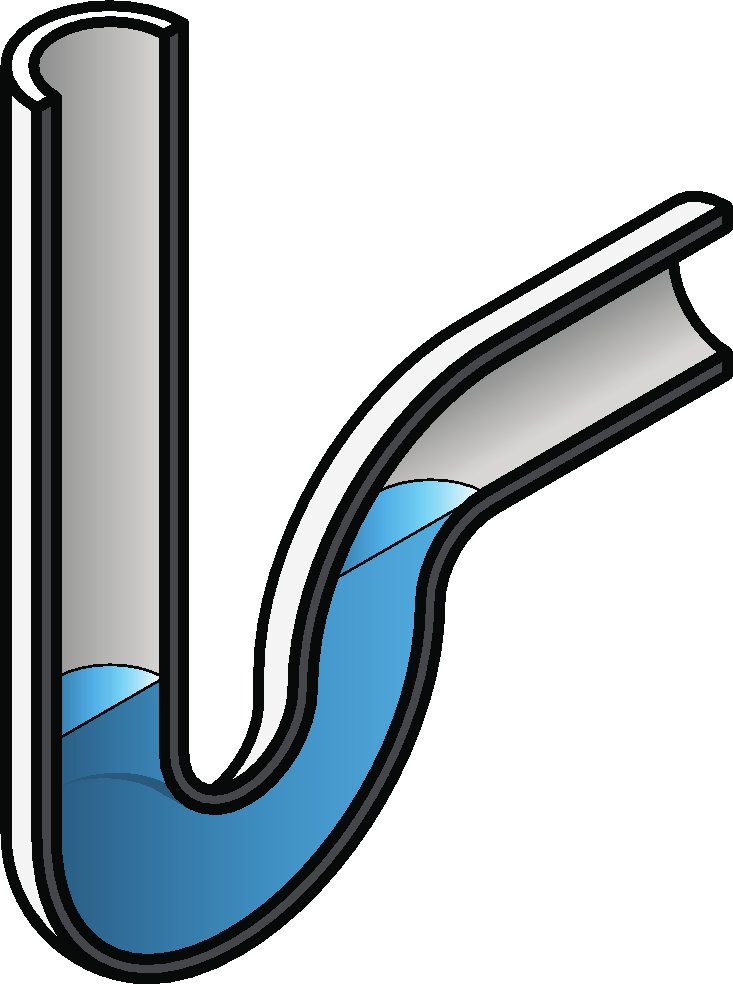There are basically two types of drain traps found under a sink in your home; a P-trap or an S-trap. As you can see from the pictures below, they get their names from their shape.
P Trap
S Trap
We commonly find drain trap issues when conducting a home inspection in older homes or in basement DIY projects for bathrooms, laundry tubs, and wet bar sinks. We call these out as in need of correction because some traps, S-traps in particular, haven’t been allowed by the Minnesota Plumbing Codes for the last several decades.
Why Are Drain Traps Important?
The purpose of a drain trap is to seal off the drain system with a water seal. Not having a water seal can allow sewer gases to back up into the room. Some of these gases are smelly, and others are odorless. There’s the potential for methane, carbon monoxide, hydrogen sulfide, and ammonia to escape if the water trap is open. Now, this seems like stuff from a sci-fi movie, but vermin can also enter your home through sewer drains if you do not have a properly working sink trap with the proper water seal.
S-traps and P-traps
S-traps were used in the early 20th century as homes were either built with indoor plumbing or had it added. It was a good idea at the time versus no trap at all. The problem with S-traps is that, for example, if you drain a sink full of water, the suction or siphon created by the water going up and over the top loop can pull, or siphon, all of the water out of the bottom loop, leaving no water seal.
P-traps are designed to eliminate the siphoning of the water seal. With a minimum horizontal extension and intersecting to a vertical drain, a P-trap will break the potential siphon, leaving the water seal intact.
Both the S-trap and P-trap designs can lose their water seal in sinks that have not been used for an extended period. The water in the trap can evaporate and leave you without a water seal. Just add a little water and you should be good to go.
Venting
In addition to the introduction of the P-trap, home plumbing systems also require drain waste venting (DWV) to the exterior. A vent “stack” or vent pipe is used in the plumbing system to eliminate any negative pressure in the drain system. The vent pipe will typically run vertically within the wall system of the home, through the attic and roof to the outside. On larger homes, there can be more than one vent stack.
A device known as an Air Admittance Valve (AAV) is an alternative to a vent stack and is sometimes added to older plumbing systems under sinks or areas where it’s not possible to tie into the home’s vent system. An AAV works by allowing air to enter the plumbing through a one-way valve. This will help to equalize the internal pressure of the drain system without letting sewer gases escape.
AAVs must be installed so their inlet is higher than the drain at the bottom of the sink to prevent overflow or back-up.
It must also be noted that, even though AAVs are available at your local plumbing supply or big box store, they may not be allowed by your local code.
Summary
If you have any S-traps in your older home and have issues with foul smells, you may want to look into converting your sink drains over to a P-trap and possibly venting, either by adding a vent stack or an AAV. Of course, there have been times when a homeowner will tell one of our home inspectors that they’ve lived in the home for several years and there has never been a problem. While they’re probably telling the truth, the problem still needs to be addressed; codes are changed for a reason.
Visit our website to learn more or to schedule your home inspection in the Rochester, Owatonna, and Faribault, MN areas. You can contact us today at (507) 202-8942 or use our online “Schedule Now” feature to set up an appointment.


